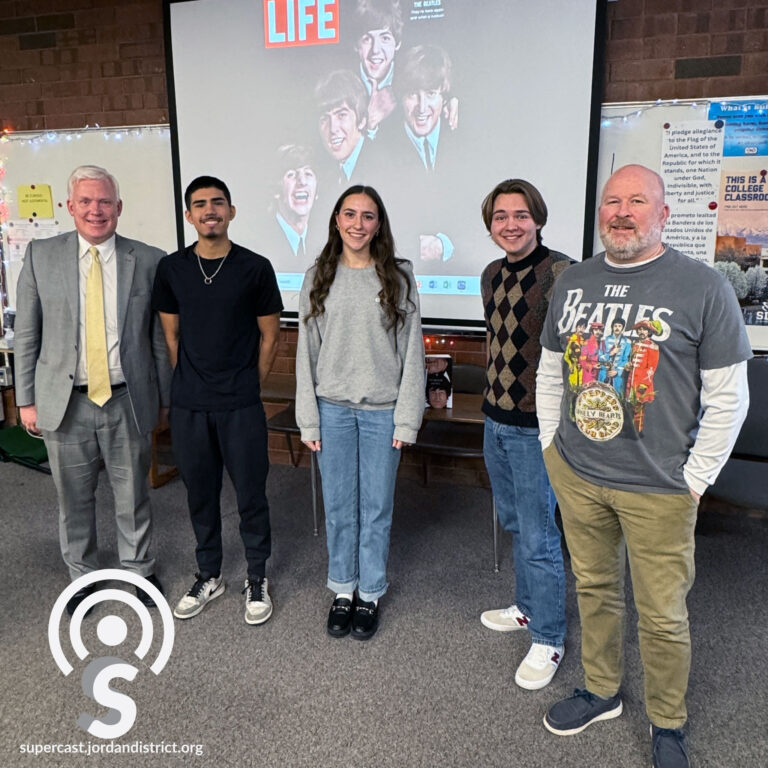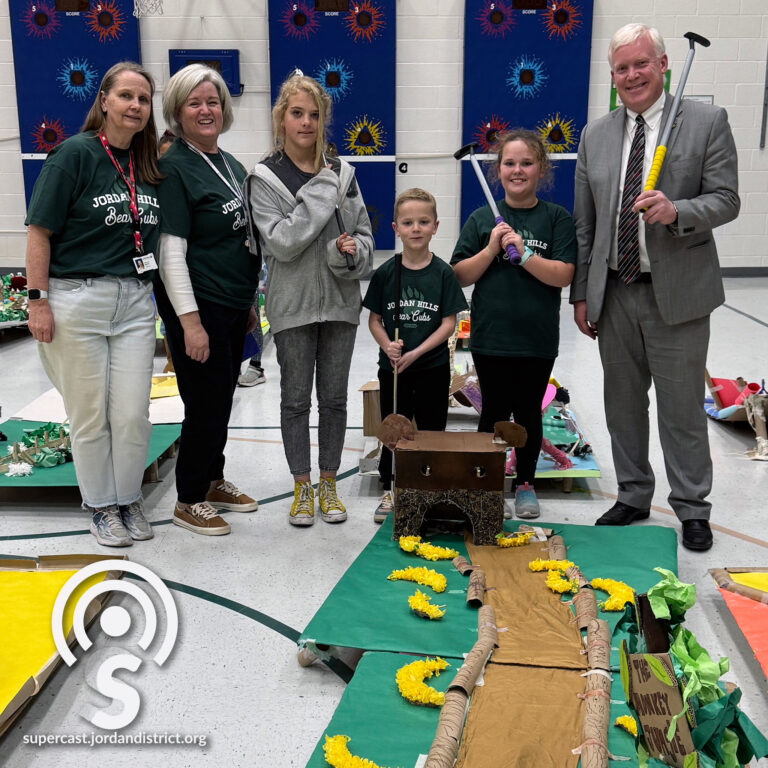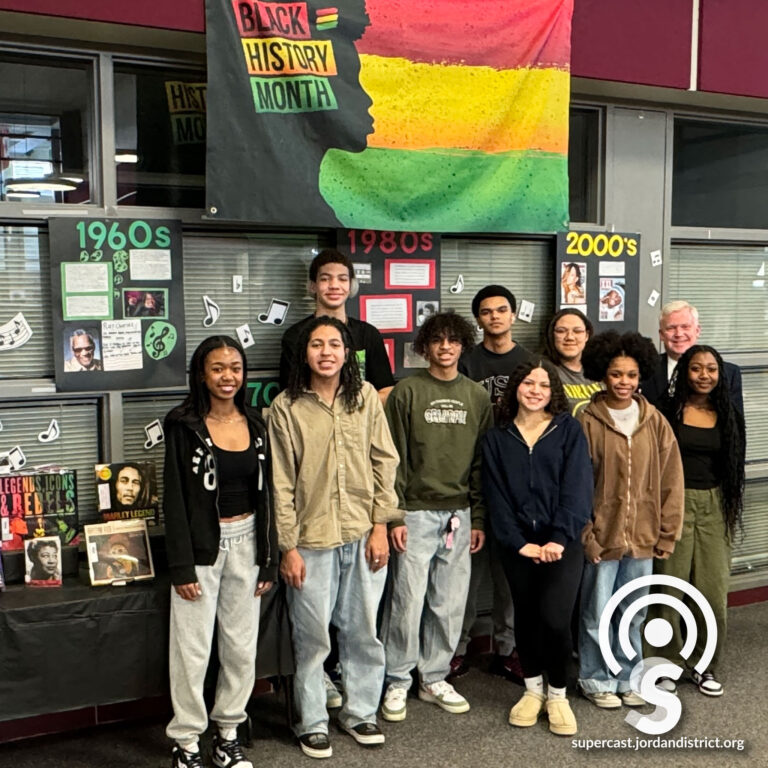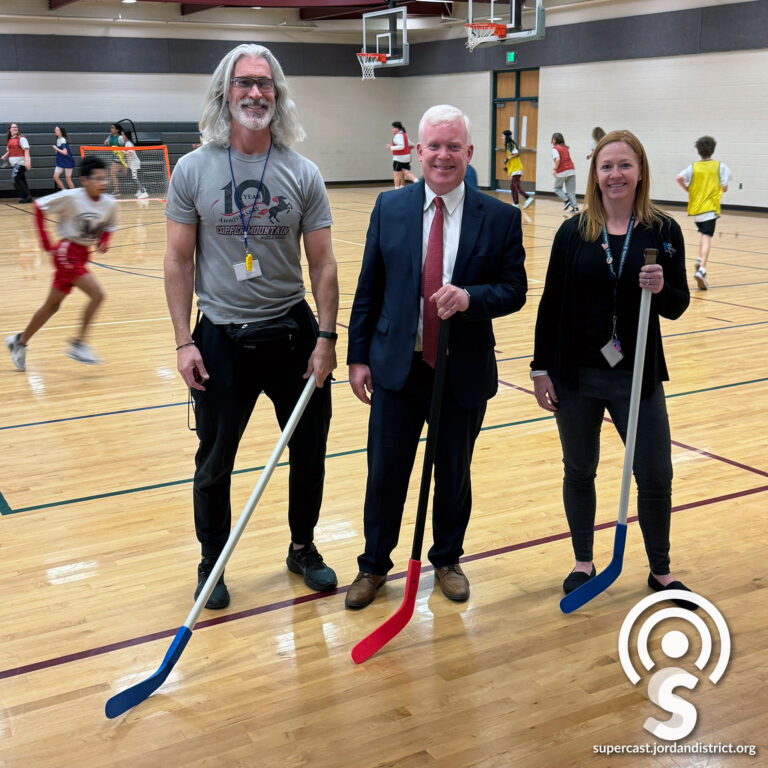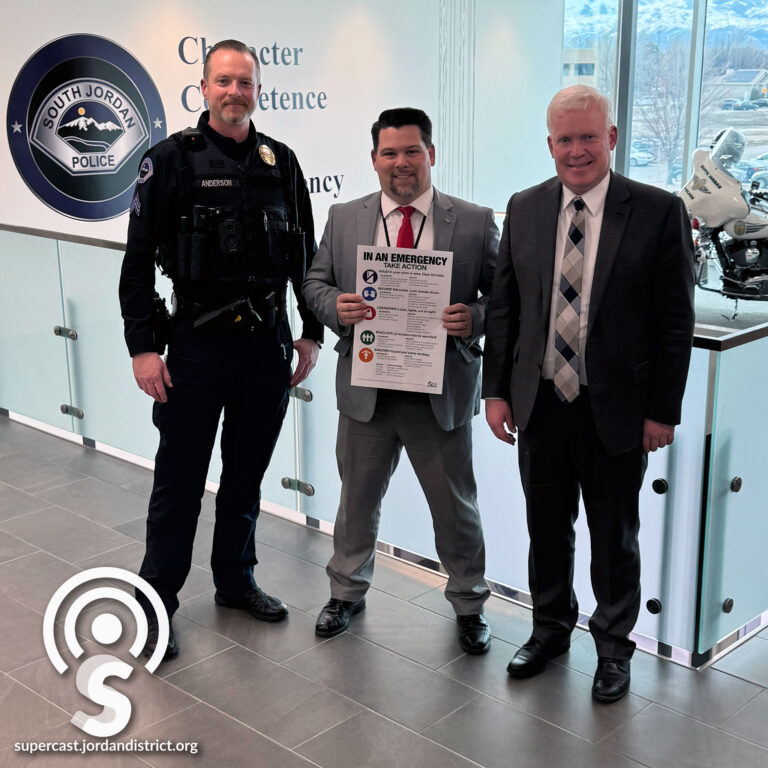Supercast Episode 239: Creative English Class is Music to The Ears of Students
It is a creative English class that is music to the ears of students who are taking the course.
On this episode of the Supercast, we visit West Jordan High School where a teacher who is passionate about music, is making students look at songs in a much more meaningful way. From the Beatles and beyond, join us as we find out why students say their teacher, Mr. Jorgensen is truly rockin his lessons on music culture and helping them understand the meaning behind some of the greatest songs of all time while discussing rhetoric of music.
Audio Transcription
[Music]Anthony Godfrey:
Hello and welcome to the Supercast. I'm your host, Superintendent Anthony Godfrey. It is an English 2010 class that is music to the ears of the students taking the course.
On this episode of the Supercast, we visit West Jordan High School, where Ben Jorgensen is teaching students to be passionate about music and is making students look at songs in a much more meaningful way. From the Beatles and beyond, join us as we find out why students say their teacher is rocking his lessons on music culture and helping them understand the meaning behind some of the greatest songs of all time.
[Music]We're here at West Jordan High School in Mr. Jorgensen's class to talk about the Beatles and music and culture and all kinds of things. Mr. Jorgensen, thank you for inviting us here. We're here with a few of your students as well. Tell us a little bit about this course and this is the culmination of a particular unit. So tell us about what's led you to today.
Ben Jorgensen:
Okay, so I've been teaching at Salt Lake Community College for about 12 years. I've been teaching concurrent enrollment for about six years. When they started letting me teach English 2010, I talked to some other teachers about what they were doing with it because I knew the curriculum was about rhetoric. A lot of them did some really creative things with it. Basically, the idea is that you get to explore rhetoric in its different forms. So I put together several units and because I'm kind of a music fanatic, I developed this rhetoric of music unit. We also have a rhetoric of service unit where they do service projects. We also do have a rhetoric of public speaking where they give TED talks. But this is where we start, and this is the longest unit. So I've kind of developed it and tweaked it over the years. I've just gotten a lot of great satisfaction out of it and students seem to enjoy it for the most part. They learn a lot about kind of the history of music, how it developed, and we focus mostly on modern music from like the 1950s on.
One of the main things that we do is I have a list of albums, impactful albums over the past 60 years. I have five albums from the 60s, five from the 70s, 80s, 90s, etc. Each student has to take one of those albums and do a rhetorical analysis research essay where they research the music, the artist, and the historical impact of that album. Big albums like Michael Jackson's Thriller, any of the Beatles albums, we do Joshua Tree from U2 and we get into even more modern stuff. I think in the 2010s there's an album by a band called Lord Huron on Strange Trails which is also one of my favorites. So yeah, that's kind of where it's gone.
Anthony Godfrey:
Boy, that's fantastic. In this moment I wish I could go back in time and take your class as a high school student. What are some of the changes that you see in students through this music unit in particular? What are some of the discoveries that they've made over the years?
Ben Jorgensen:
Well, they realize how much music does impact culture and their own lives. We look at lyrics and meaning and message. We talk about just sound and tone and how music makes us feel. We do visual rhetorics. We look at a list of music videos and we kind of comment on how the visuals affect how we understand the song or the message of the music. This symposium that we do at the end, I'm always slightly worried that it's going to go well and then I'm always completely relieved that it went really, really well. It's an academic intellectual conversation about the Beatles and that's a pretty fun topic to have.
Anthony Godfrey:
Having the chance to sit in here and watch kind of a fishbowl discussion where you have people out in the crowd watching the six and then they can tap each other on the shoulder, step in, take their place, and join the discussion. It was really hard for me not to jump in and share my opinion because it was so it was such a great environment. It's obvious that you've created this really productive dynamic in your class where people have meaningful conversation with each other, draw each other's opinions out, react in a way that it provides a really deep rich learning. So that was really fun to watch and hard not to be a part of.
So let's turn to you students. Tell me a little bit about, first of all, the unit before we get to the Beatles. How has this changed your view of music and its impact?
Abby Phillips:
I'm Abby Phillips and I say that music is one of the most important things in my life because I'm a dancer. So every day I'm listening to music and I'm expressing myself through movement to music. So it's actually been really cool to be able to apply school to my interests. And so I just think it's really interesting. It's been one of my favorite units I've ever studied in school because I actually care about it. It's just really fun to be able to learn about something that you don't really get to learn about in school.
Ashton:
Yeah, my name is Ashton and I think it's great to have a class all about you in music. My family, my mom's side is from the west coast and my dad's side is from out east and so I grew up listening to any type of music you can imagine. It's always been such a huge part of my life to listen and learn about music. This class specifically about rhetoric, it's very interesting to think of music as a tool to persuade rather than just a song. So it's definitely changed my mindset in that I'm more looking into the ways that artists can persuade an audience to listen and can push their message forward. It's very interesting.
Arlen:
My name is Arlen and honestly this class has been extremely thought-provoking. I like how you dove into your background with music in terms of your father's side and your mother's side because my family is very rooted in Mexico. My stepdad's even Mexican, my mom and my dad are Mexican and then all the way up to my grandparents. So at home, it was a lot of songs that were in Spanish and if it wasn't songs that were in Spanish, it was my older brother playing rap music. So when I was young I grew up listening to a bunch of rap music, some songs in Spanish but it never really appealed to me. So taking this class really– it opened my eyes. I never really dove into the past, I didn't listen to any slower music, I always liked my music fast with not the best lyrical content but you know definitely something.
Jorgensen just opened up my mind to the past. There's a couple of artists that already stuck with me. I know I had to pick the song “Fast Car” by Tracy Chapman for one of my projects and I listened to that song on repeat. Now I get in my car I'm like shoot I don't have a fast car but I've got a car.
I mean, in terms of rhetoric and music I think it's honestly phenomenal. I did a speech just recently in this class about Bob Marley and his effect on music. To do that speech I went to go watch the movie on Bob Marley. So I've been thinking ever since that movie and being introduced to the Beatles, I've been thinking how they appeal to the audience and how the message isn't separated from the music. Actually, Bob Marley says that in the movie, but I think it's just amazing to connect both of those into one. Especially because now I feel like a lot of the rap music that I listened to and a lot of the music I listen to now is very disconnected from the message they want to push. So being able to listen to some of the older music where the Beatles are pushing love and positivity and other people are talking about their own personal trauma and past, I think it's really been amazing to just kind of reflect on myself and reflect on how it affected others at that time to honestly become a better person through the music.
Anthony Godfrey:
So Bob Marley is in particular one that has caught hold of you through this unit.
Arlen:
Oh yeah, most definitely. And you know I just want to point out now that I have the mic I think it's kind of hilarious that Mr. Jorgensen came in the Beatles shirt. I've never seen him in anything other than a suit and tie so I think it's pretty funny.
Anthony Godfrey:
Well, I do like when Bob Marley tells me “every little thing's going to be all right. Don't worry about a thing.” It works. What are some of the artists that the two of you have discovered through this music unit?
Abby:
Well, I have grown up listening to the Beatles. My grandfather's a big fan of them but I think that it really just opened me up to like listening to them in a way I never have before. Like I've never dove into their music and they're singing about the time that they're in and how impactful their messages actually are. And we're gonna learn about like who they are and how they came together and how they fell apart. It's just like the more you know about the artists the more meaningful the music actually is to you. So I think that's been really interesting to actually learn about the Beatles. Not just their music but who they were and how they impacted others. So that's really cool.
Ashton:
I think I have a story that kind of contrasts pretty crazily with I think a lot of people in this class in that I've been listening to music from the 60s and the 70s my whole life and so I know a lot about these bands. This class has kind of pushed me to listen to more modern music. I guess it's not super modern, but I'm talking to talking to Jorgensen all the time he's gotten me to listen to bands like Crowded House and U2 a lot more. I've heard of them but I've never actually took the time to listen to them. I love Crowded House. I think it's a great great band and I'm glad that I got to experience that through this class.
Anthony Godfrey:
I love hearing how it's this class has expanded your listening taste but also impacted your lives in the way that you view the world. It's nice that you get to stream music. I was telling my son last night just how if I listened to music they had to decide to play it on the radio or I had to actually buy it. And when you invested in music you really gave it a deep listen. I think this class gives you that experience as well that you give things a deep listen.
Stay with us. When we come back, more with Mr. Jorgensen's class.
[Music]Break:
Does your student want to become a veterinarian, commercial pilot, programmer? Maybe they want to make a difference as a dental assistant. These are just some of the programs offered as part of Career and Technical Education, CTE in Jordan School District. CTE provides the technical skills needed to prepare students for future employment or a successful transition to post-secondary education. Career and Technical Education provides work-based learning opportunities. We partner with industry experts to offer apprenticeships and internships with students working in the real world at real jobs while going to school. The CTE experience starts in our elementary schools with the Kids' Marketplace and grows through middle and high school. To explore all CTE has to offer in Jordan School District visit cte.jordandistrict.org today and let's get your child started on the pathway to a profession.
Anthony Godfrey:
I really want to dive into the Beatles now so I'm going to ask all the Beatles questions. First of all, your favorite song. Tell me your favorite Beatles song and that's a tough one to pick.
Abby:
I think it's “Yesterday.” That song, it just every time I listen to it, it makes me emotional because it's just so beautiful and I love the message. It's just so well composed that it just brings out all my emotions. There's actually a movie called “Yesterday” it's about if the Beatles didn't exist. I think that like I can't even imagine not knowing that music because it's just it's all so beautiful. And so “Yesterday” is definitely my favorite.
Ashton:
Yeah, my favorite Beatles song is probably going to be “Don't Let Me Down”. I think that it's– I think obviously it's a beautiful song but I think more in retrospect, it kind of serves as a great wrapping up point for the Beatles. It's kind of on the Let It Be album but not really. It's like on the Master Edition and on the Blue album and so it like kind of wraps up the Beatles in a very nice way. It's a very beautiful song, has a very powerful message and it's pretty positive.
Arlen:
In terms of my favorite Beatles song, it'd probably be “Girl” by them or even “I Want to Hold Your Hand”. I do like “Don't Let Me Down” a lot but I'm really big on how the music sounds itself. So that's why I've loved this class actually because it's made me dive into the lyrical content of music more because I've always just been on how it sounds in my ears when I'm not really listening to the lyrics and just how the beat sounds and how it flows. So that's one of the reasons I like “Girl” so much actually. I love the the way it sounds but even diving into the lyrical content like I can't say I 100 percent relate to it. I won't say that but I do like some of the lines they say. I think it's a little bit funny. Some of them do relate to me so that would have to be my favorite song “Girl” by the Beatles.
Anthony Godfrey:
Tell me who is your favorite Beatle? Do you have a favorite Beatle?
Arlen:
I feel like I don't have the traditional favorite Beatle. A lot of people would probably say John Lennon or Paul McCartney. My favorite Beatle is actually Ringo Starr. I love the way he looks. I loved watching some of the the rooftop concert for Apple Studios was it? I loved watching that concert and kind of just seeing Ringo Starr kind of really just beat along to the music and nod his head. I feel like just the way he carries himself makes me laugh and I just it feels friendly.
Anthony Godfrey:
Yeah, it feels friendly. I love that description. Nobody's having a better time than Ringo. Ringo is just there “Hey, I'm so good I'm just gonna fill in all the gaps and do it in a way nobody else could.” So yeah I love that.
Ashton:
I'd probably say George. It's like I think John and Paul, they started as geniuses and it's like everyone knew that they were talented. George was kind of the underdog and he took the time and developed his musical talent and he really blossomed into a I think a wonderful musician. So definitely George Harrison.
Abby:
Well, it's actually funny that Arlen said Ringo because I wrote down in my notes that Ringo doesn't get enough credits for being on the Beatles. This is something that Jorgensen has discussed. Like their music wouldn't be anything without Ringo keeping that beat. And I actually do like how he just jams. And the rooftop concert, their last song they ever performed was "Don't Let Me Down". It that was a really cool video watching them just kind of-- it was just like a farewell. And yeah, Ringo looked really cool in that he was just jamming. He– I don't know he kept the music going and he's the reason that they have their beat and their flow and so yeah, he makes the songs iconic and recognizable because of that that those drums you know.
Anthony Godfrey:
Tell me, do you think that you are going to consume pop culture in a different way now because of this course?
Abby:
I think that definitely this course has given me like the idea that music is not just for the enjoyment of listening but for telling stories and getting messages out. You don't see that as much in modern music I think. I think that music was a lot more meaningful like the Vietnam War and people putting out messages. Like everything was a lot more meaningful and so I feel like I don't know, I try and listen with more intent and try and find a message from what I'm listening to instead of just jamming because it has meaning.
Ashton:
I think that Abby put it pretty perfectly. This course has definitely made me think about music nowadays and pop culture that I'm actively alive for and involved in in a more intellectual and like a more meaningful way. This class has definitely made me put more of an emphasis on learning my surroundings and trying to understand the people that are around me.
Arlen:
You know I love the way both Ashton and Abby put that, and they put it absolutely phenomenally. I actually wanted to say pop culture is more of a lifestyle nowadays than it is just a part of the culture. Every single thing you do now is a part of the pop culture. Every show you watch, every song you listen to, all the clothes you wear, is just all part of the pop culture. And the culture here in America and the lifestyle. Honestly, I do feel like I'm gonna ingest it differently now that I have taken this course and I know a little bit more about the music. But I really hope, and this this is like a far-fledged hope, like I'm really just throwing a bullet on a football field, but I really hope we can even revert a little bit back towards the times where music held a deeper message. A lot of the music now is– it's very personal, don't get me wrong, there's definitely a message there, but the music from the Beatles era was very– it was music for a country. It wasn't music for a specific group or a specific community it was music for America. And I mean, of course they took the world by storm by writing for the masses, but I really hope now and I mean maybe I'll pick up a Mic so that I can start doing what I'm dreaming of. But I really hope now that the music can spread more worldwide instead of being contained to individual areas like it has been.
Anthony Godfrey:
Yeah, I love all those comments and all of them show that this is going to have a lasting impact on you, the study that you've done in Mr. Jorgensen's class. But I think you're right, and this was discussed earlier in class, that the culture is more fragmented. Partially because there are more options, but just also because of other culture and political forces. It used to feel good that everybody knew a certain set of songs and we all had that in common and I love what you said about that. Any parting thoughts?
Arlen:
I mean the Beatles are definitely– I honestly, I'm gonna just say the Beatles is the best band to ever grace the planet of the earth. The Beatles are amazing. I said this earlier as a joke like what was it listening to the albums for the first time but I want to just put my experience out there. It was honestly like giving my heart a thump. It's like having a chocolate bar. It's like I'm gonna just take another bite and another one and another one and by the end of it, like it's better than a chocolate bar because you don't even feel bad. You're just like ‘that was great I loved listening to that’. I just keep on going so I just want to say the Beatles are the best band to ever be made. Amazing. I love the class thank you so much for having me Jorgensen.
Ashton:
Yeah, the Beatles are definitely the best. I remember the very first time that I listened to Sgt. Pepper from the beginning to the end, no breaks. It's such a crazy experience. It's not– you're totally captured and that's not just Sgt. Pepper, it's every album. But Sgt. Pepper is just I think a culmination of greatness, and so them as a band they're just wonderful.
Abby:
I think that everyone no matter your age needs to listen to the Beatles because like Arlen said, they're the greatest band of all time. They changed the face of rock and roll. They changed like what you would normally think rock and roll is. They totally rearranged it and gave people a different idea of what it was. They pushed boundaries and they made really impactful music. So everyone everywhere needs to listen to the Beatles, no matter what.
Anthony Godfrey:
Well, any parting Beatles thought?
Ben Jorgensen:
Just it's been fun. It's a fun unit. I've received so much good feedback from my students and from others about this unit I feel like it is impactful. It is an academic pursuit to be able to look at something and break it down intellectually. Look at lyrical content messages everything like that. It certainly relates to rhetoric, persuasion, impact and I'm just grateful I get to do it it's fun.
Anthony Godfrey:
It's fantastic it's so it's so fun to be part of it today thank you very much for your time and happy listening.
Thanks for joining us on another episode of the Supercast. Remember, education is the most important thing you will need today. We'll see you out there.
[Music]
